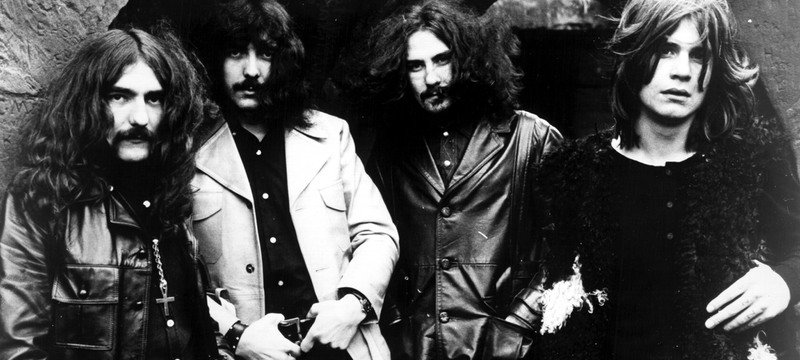Heavy metal, often referred simply as metal, is a genre of rock music that developed in the late 1960s and early 1970s, mainly in the United Kingdom and the United States.
Has its roots from blues-rock and psychedelic rock. The bands that created the genre developed a heavy, massive sound, characterized by high amplified distortion, extended guitar solos and emphatic beats.
The Allmusic states that “in all formats of rock ‘n’ roll, heavy metal is the most extreme form, in terms of volume, and theatricality.”
The first heavy metal bands such as Led Zeppelin, Black Sabbath and Deep Purple attracted large audiences, a common attribute in the entire history of the genre.
In the mid-1970s, Judas Priest boosted the evolution of the genre by removing much of the blues influence present in the first generation of British metal;
Motörhead introduced aggressiveness and anger in the vocals, the influence of punk rock, and an increasing emphasis on speed.
Bands of the “New Wave of British Heavy Metal” as Iron Maiden followed the same line. Before the end of the decade, heavy metal had attracted a crowd of fans worldwide known as “metalheads” or “headbangers”.
In the 1980s, glam metal became a major commercial force with groups like Mötley Crüe.
The Underground produced a series of more extreme, aggressive styles scenes:
Thrash metal broke into the mainstream with bands like Anthrax, Megadeth, Metallica and Slayer, while other styles like death metal and black metal remain as phenomena of the metal subculture.
In the 1980s, the power metal was also created, with bands like Helloween and Blind Guardian.
Since the mid-1990s, popular styles such as alternative metal and its most famous areas: industrial metal, nu metal and rap metal, often incorporating elements of hip hop and funk.
For its part, metalcore, hardcore punk that combines with extreme metal, have further expanded the definition of the genre.
1. Black Sabbath
The band was formed in 1968 in Birmingham, UK.
Originally composed by Ozzy Osbourne (vocals), Tony Iommi (guitar), Geezer Butler (bass) and Bill Ward (drums).
Subsequently, there were numerous changes in band, and Lommi was the only fixed element.
Though often classified as a hard rock band (Butler once defined the style as “a heavy, distorted blues”), Black Sabbath is considered one of the pioneering heavy metal bands, with crucial influence on the development and definition of style . Since its formation, has sold over one hundred million copies of albums.
2. Judas Priest
Bassist Lemmy Kilmister started in music even in the 1960s, as a roadie for Jimi Hendrix’s band. His professional beginning in the arts took place with the psychedelic rock band Hawkwind, who reached a few hits in the 1970s.
Later Lemmy would be fired from Hawkwind to have been arrested at the Canadian airport for possession of drugs.
Lemmy Klimister didn’t gave up and decides to create a band together with the musicians Larry Wallis and Lucas Fox, the Bastards, but quickly changed its name to Motörhead (American slang for amphetamine addicts).
4. Iron Maiden
Iron Maiden, a British heavy metal band, formed in 1975 by the bassist Steve Harris, ex-member of the bands Gypsy’s Kiss and Smiler.
Originally from London, was one of the leading bands of the musical movement known as NWOBHM (New Wave of British Heavy Metal). The name “Iron Maiden”, namesake of a medieval torture instrument that appears in the film The Man in the Iron Mask, based on the works of Alexandre Dumas.
With almost four decades of existence, fifteen studio albums, six live albums, fourteen videos and many compacts, Iron Maiden is one of the most important and successful bands in the entire history of heavy metal, having sold more than 100 million album registered throughout the world. His work influenced many bands of rock and metal. Are cited as influences by many bands, old and new.
Today, they are still considered by the vast majority of sound technicians as the best rock band live.
5. Ozzy Osbourne
Metallica is an American metal band formed in Los Angeles, California. Their songs include quick times and aggressive musicianship, which put them in place of the “Big Four” of thrash metal, along with Slayer, Megadeth and Anthrax.
The band was formed in 1981, after James Hetfield responds to an advertisement that the drummer Lars Ulrich placed in the local newspaper.
In 2003, the group is now composed by lead guitarist Kirk Hammett (who joined the band in 1983), the bassist Robert Trujillo (member since 2003), Hetfield and Ulrich.
Before arriving at its current formation, the band had several members: lead guitarist Dave Mustaine (who later founded Megadeth), and bassists Ron McGovney, Cliff Burton and Jason Newsted.
